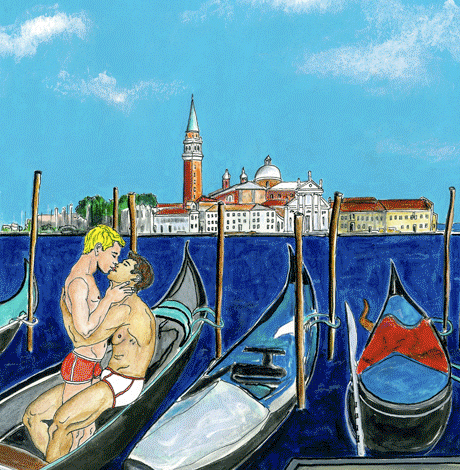 |
| Spot the anachronism |
... depicting the Lido of Venice. All this while we are excerpting a biography about Lord Byron providing deeper insight into his sex life, including his life in Venice (spoiler alert: self-serving ellipsis ahead)---Byron will feature in the second part of our episodic novella "The Grand Tour"---John and Alex from the Green Eyes finally marry and are off to Europe where they end up at the feet of the Fountain of Geneva whose story they learn from Richard Zugabe, librarian of the Geneva City Archives and owner of an apartment in the Villa Diodati nearby. Right, that's the first chapter of "The Grand Tour" which segues into a tryst at Zugabe's place and evokes the narrative material about Byron who had rented the villa in 1816 & who looked EXACTLY like Bill Clinton & who had apparently left a cache of manuscripts behind the wood paneling of his bedroom---for Richard Zugabe to discover.
 |
| The young Bill Clinton---sorry, just kidding, "George Gordon, 6th Lord of Byron," William Edward West, (1822) |
So, now, we read the Byron biography, and are reminded of Venice, the place where Byron installed himself for three years after having left Geneva. Venice, unfortunately, is not the most homosexual period of Byron's life, but we are learning a lot about the mores of La Serenissima during it's "days of woe," [quotes are sometimes literal Byron] in the early 19th century. That stuff possibly won't go into the novella, so let's share it here.
Byron shows up in Venice and is taken into the embrace of Marianna Segati, 22, wife of his landlord and mother of two children. It's "fathomeless love" between Byron and Marianna and everybody is happy not only because the Signor is already ensconced in his own extramarital affair, but because it's deemed unseemly in Venice to be married without baggage on the side. So Byron finds himself cast as cicisebeo or cavaliere servente, the wife's acknowledged companion. And when he's not making love to Marianna (she's always "flushed," the lord observes, due to "her constant state of arousal"), Byron's off to the ridotto gambling clubs where everybody's wearing Harlequin masks and sharing anonymous sex in the darkrooms upstairs. Yep. All this while "Venice's palaces are crumbling piecemeal into the canals and filling them with debris."
(Note:) there's also paid sex, I quote from the biography: "Certain noblewomen, after losing all their money, were compelled to sell their favor for the price of returning to the play."
Then there's the carnival. I always thought this was mostly for touristic consumption, but no, it seems to define the seriality of Venetian life when everybody is "swept into a frenzy of lust," "fiddling---masqink---singing and't other thing." Carnival is also the season to change lovers, and Byron duly obliges, although, "within marriage, sexual fidelity is seen as risible; a pair of adulterous amorosi, however, known to be faithful to one another for years, is exalted as the highest form of morality." Yep.
There's only one brief remark on Byron trolling into gay territory when bourgeois poet-friend Shelley visits who needs to be duly shocked by lordly decadence and is confronted with a Byron who (this is Shelley now:) "associates with wretches who seem to have almost lost the gait and physiognomy of man & who do not scruple to avow practices which are not only not named but I believe seldom ever conceived in England." Yep.
Our "Grand Tour" novella will provide a trip through the homosexual history of Europe and perhaps end with Thomas Mann, a closet gay if there ever was one, and so we may have a final chapter on the writer and his "Death in Venice" ... right, that was Visconti's movie, but is was also a novella by Mann about a writer being smitten by a beautiful youth whom he then stalks along the Venetian canals. In Visconti's movie the writer has transmogrified into a composer (the suggestion is Gustav Mahler, although Mahler was straight as a reed), and the Steinert picture, that's Dirk Bogarde happening upon Björn Andrésen in the film. Yep.
That's why we post this post as posted. We happened upon this beautiful picture, and wrote a story around it. Right, so here's another Venice-Steinert picture:
For the previous post on Venice, go here.


No comments:
Post a Comment